When visiting El Salvador, you will likely travel through its capital at least once. Instead of passing by without stopping, we think it is worthwhile to spend a day exploring San Salvador and area. You can fill your day by visiting the city’s downtown in the morning and Joya de Cerén Mayan archeological site in the afternoon.
Click on the link to go directly to Travel Tips For El Salvador.
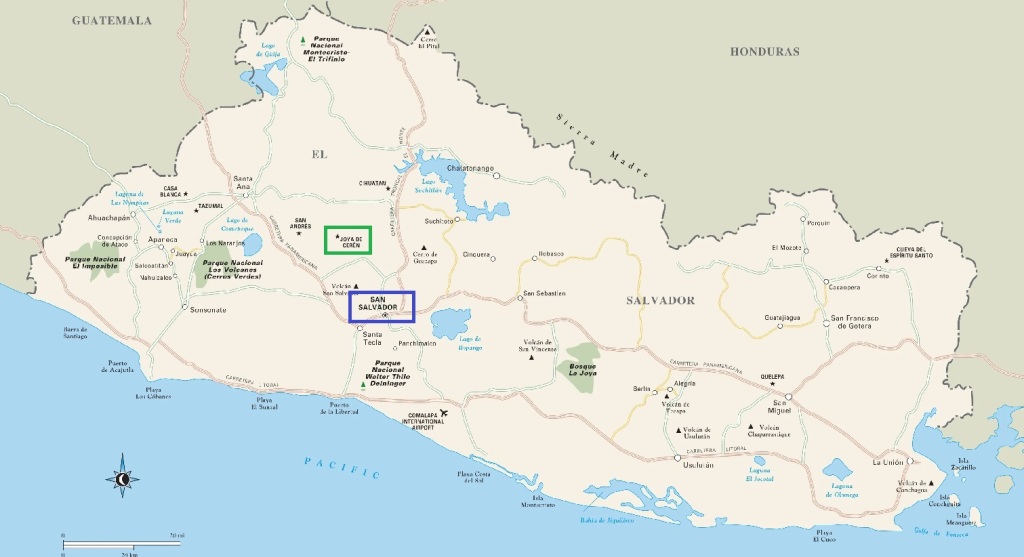
The largest city and capital of El Salvador had a reputation for being one of the most dangerous cities in the world. That was definitely true in its past, but fortunately, a recent government crack down on gangs has turned it into a relatively safe city for both visitors and residents. The city is still rebuilding from these years of unrest, but there are a few newly restored sites in the city’s downtown that can be visited in a half-day.
Plaza Gerardo Barrios
Begin your exploration at the city’s main square, Plaza Gerardo Barrios. On one side of the busy park is the National Palace. It is rather grand looking, built in the Neoclassical style. The original palace burned down in a fire in 1889, so this new building is from the early 1900s.
When we arrived there were a couple dozen heavily armed soldiers protecting the building. It is the former house of the president and legislative assembly but hasn’t been used by government since the 1970s. Today it is used for ceremonial events and receptions as well as housing the state’s archives. The soldiers were gone by mid-morning so we suspect there was an important event taking place inside when we first arrived.
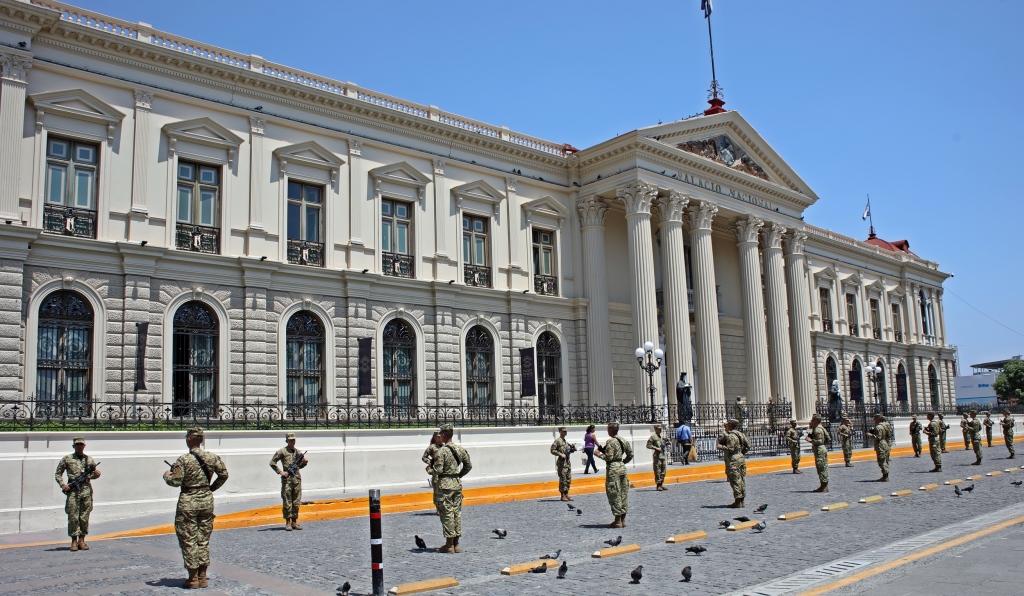
In front are statues of Christopher Columbus and Isabella I, wife of 15th century ruler King Ferdinand II. It seemed strange to have Spanish statues prominently displayed outside since the palace was built after they achieved independence from Spain in 1821. We learned that the statues were a gift to the country by Alfonso XIII who was King of Spain in the early 20th century. They were to commemorate the 432nd anniversary of Columbus’ landing in America, making the statues seem even more inappropriate and odd.
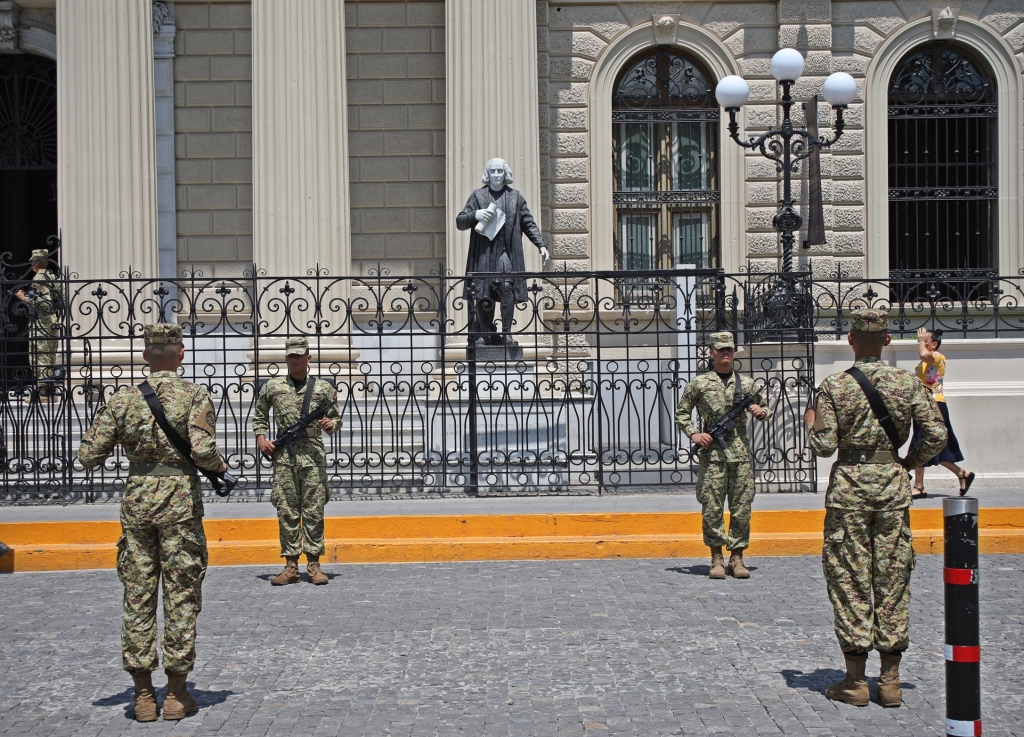
The other notable building on the square is Cathedral of San Salvador. The exterior is rather simple but inside, the wooden designs on the ceiling and paintings on the altar make it appear much more elaborate.
The tomb of San Salvador’s beloved archbishop Óscar Romero is housed in the church. He was known for his support and aid to the needy as well as being a vocal critic of the military backed junta government. In 1980 he was shot by a military sniper while giving mass. Two pictures of him are positioned prominently at the front of the church.
You can read more about the military junta and guerilla rebels in our post Visit Colonial Suchitoto.
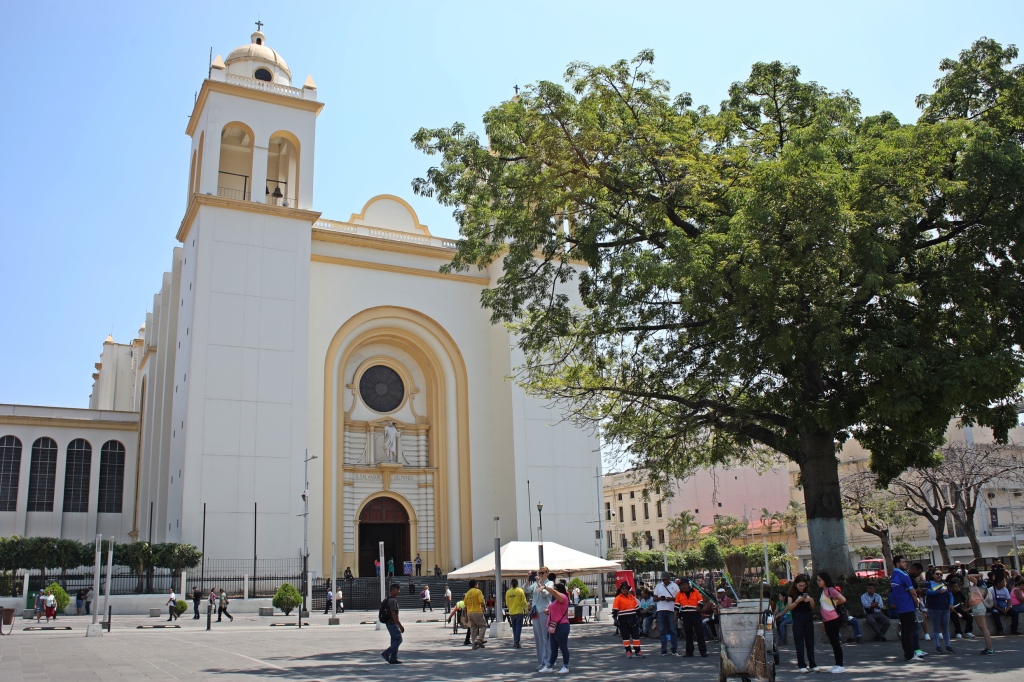
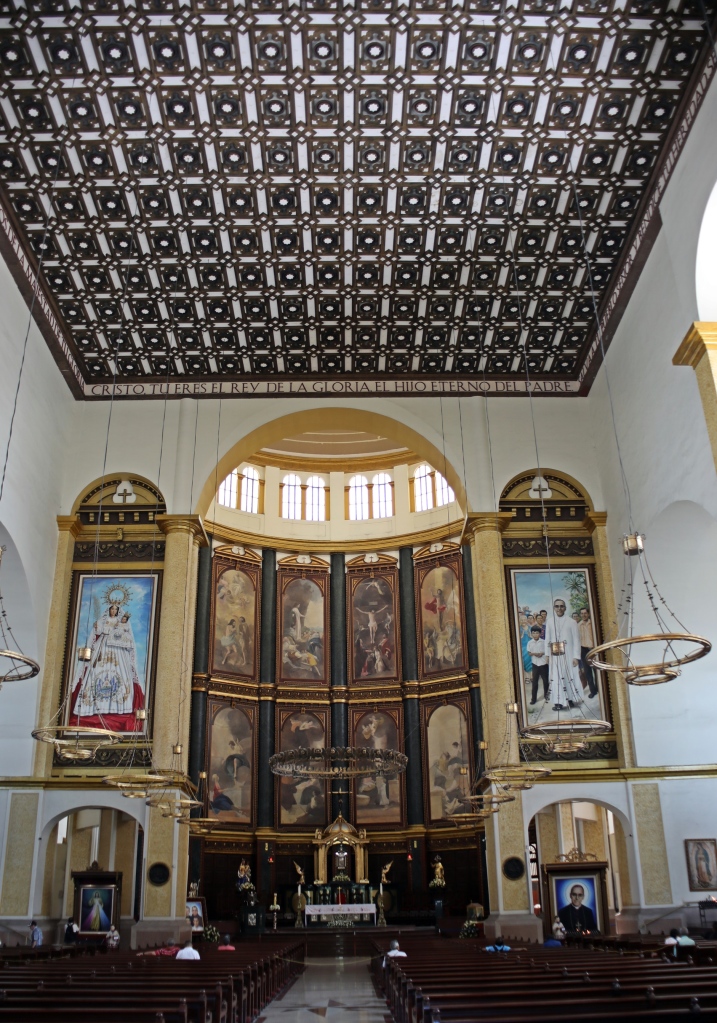
Across from the Cathedral is the modern National Library. Construction of the new building began in 2022 with financial help from the Chinese government. This is the second structure we saw that was built with aid from China. The other was the new pier in La Libertad.
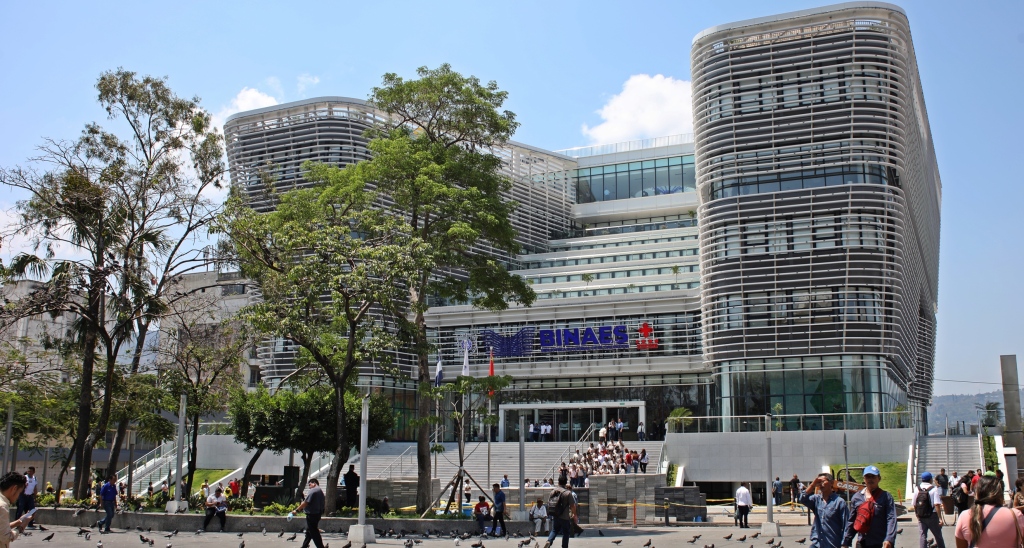
Plaza Morazán
A block from Plaza Gerardo Barrios is a smaller square that is home to the elegant National Theatre of San Salvador. Built in the early 1900s it has a variety of architectural styles melded together such as French Renaissance, Rococo, Romantic and Art Nouveau. It is apparently open for tours but was closed when we were there.
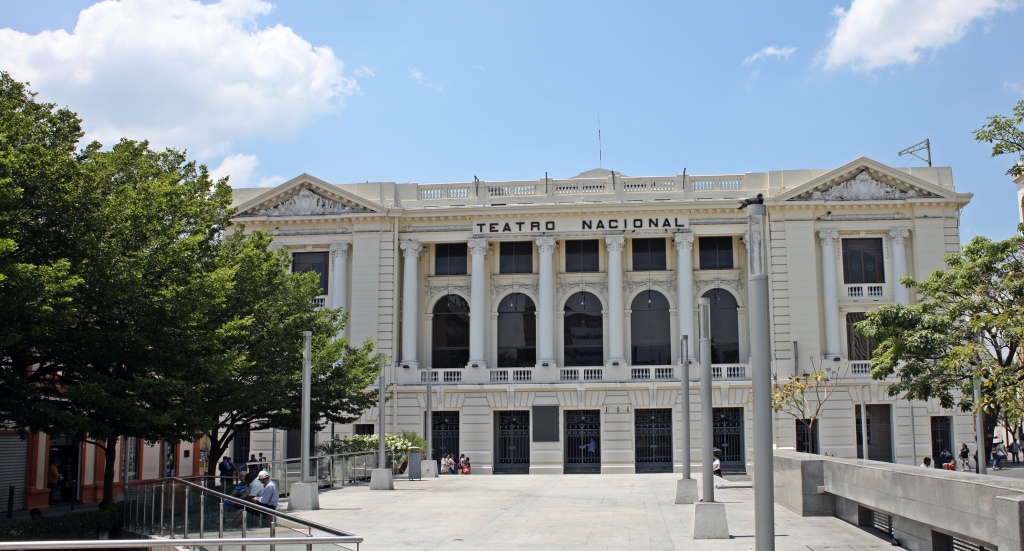
Plaza Libertad
With the cathedral’s dome and bell towers poking over head in the background, Plaza Libertad may have the most interesting building in the city. Iglesia El Rosario (The Rosary Church) was built in the late 1960s by Salvadoran architect and sculptor Rubén Martínez. The modernist-style church was built to replace a deteriorated wooden one.
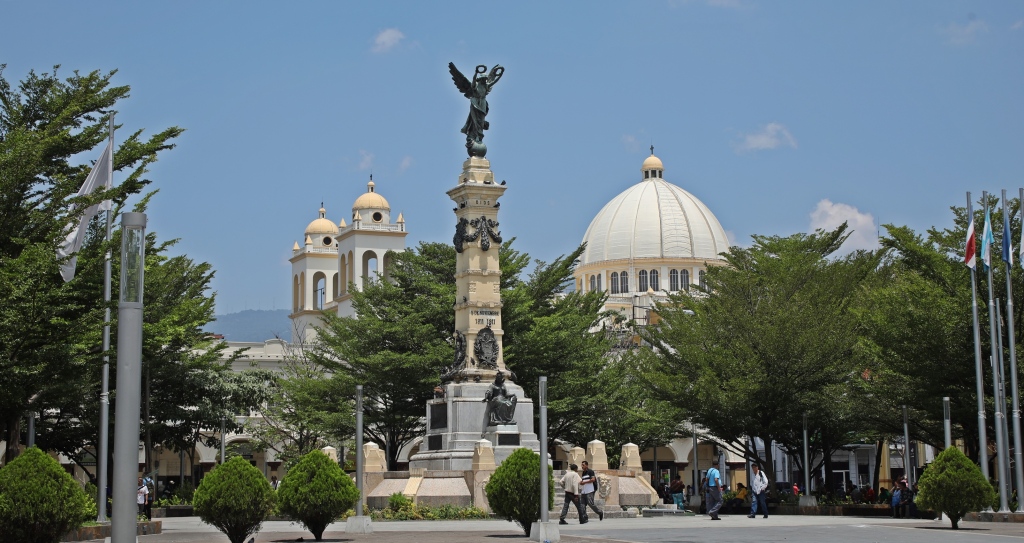
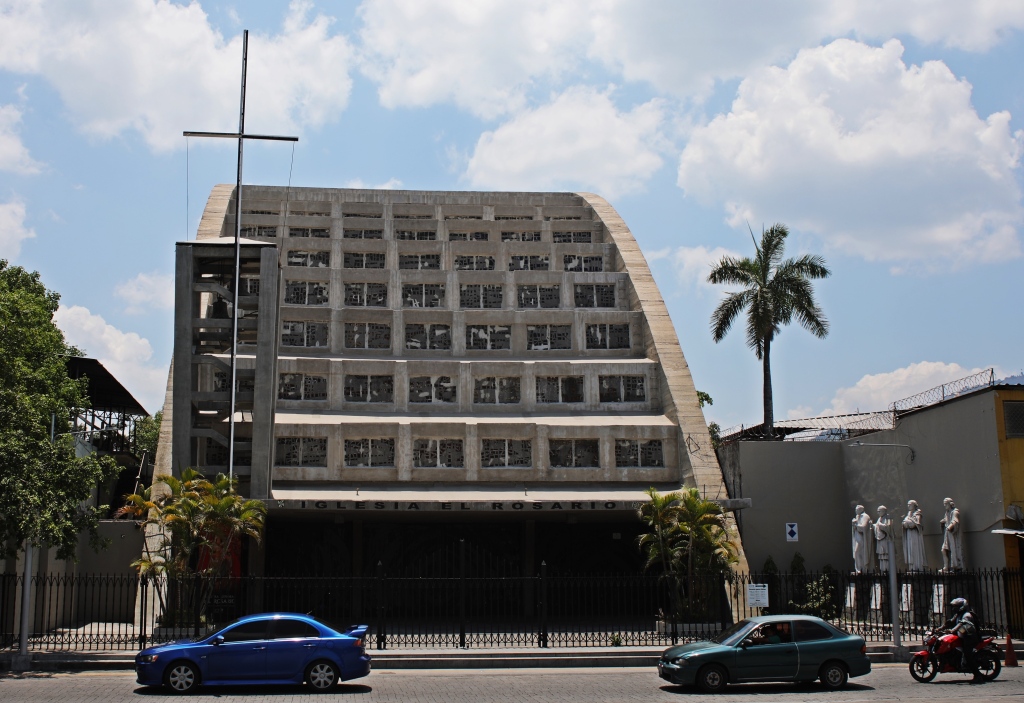
Concrete makes up the walls and ceiling of the large arch-shaped building. Colour floods in through linear breaks in the cement that are filled by stained glass. More colour is added by the light’s reflection off the polished floor.
The contemporary design reminded us of Metropolitan Cathedral in Rio. You can see pictures of it in our post Rio’s Historic Downtown.
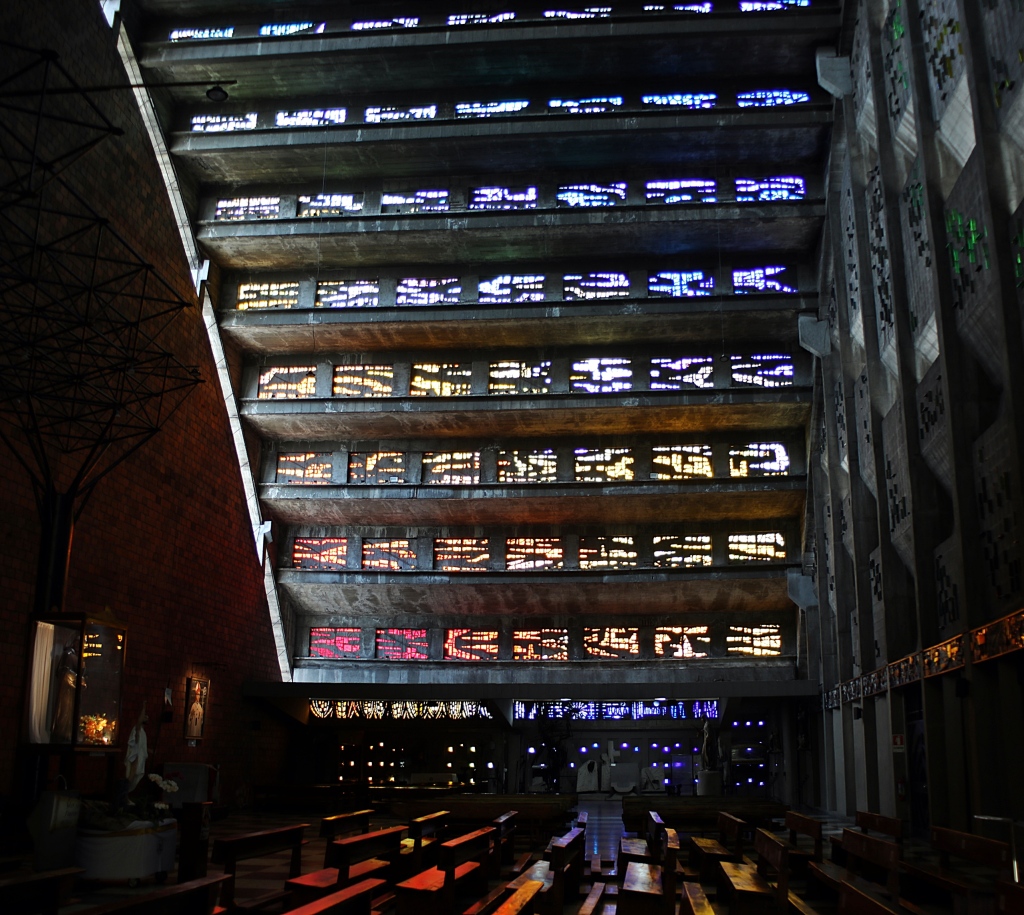
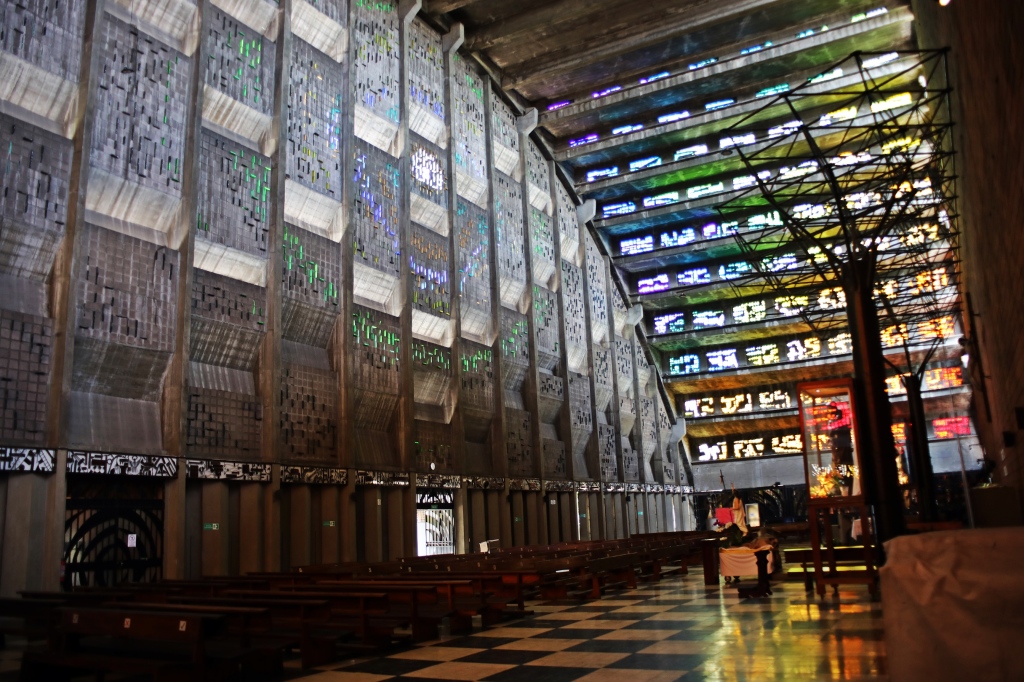
There is also an art installation by Rubén Martínez in the church. It comprises a modern art depiction of the 14 Stations of the Cross. All pieces were made with left over material from the church’s construction.
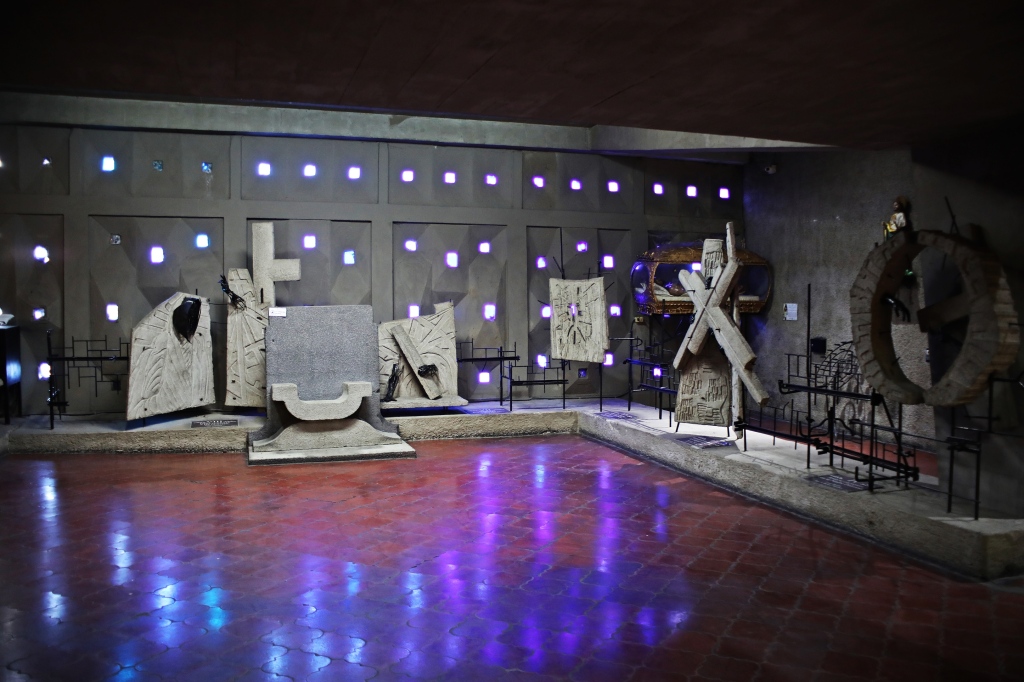
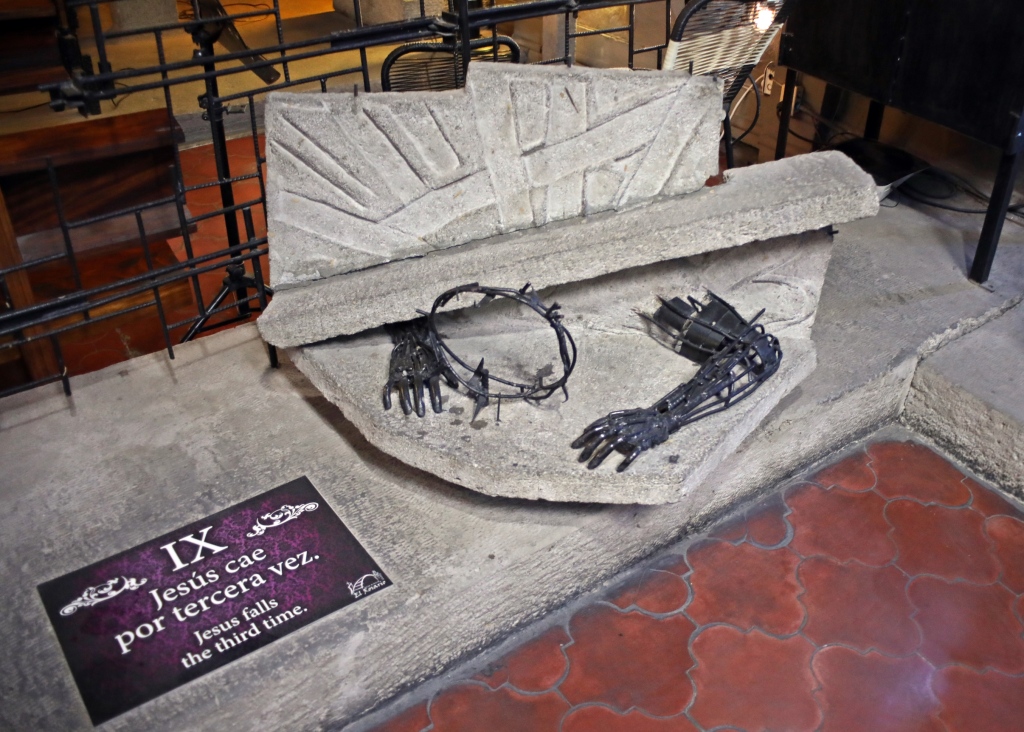
Like many buildings in the country the church is connected to the country’s hardships. The building was used as a shelter for hundreds of families seeking refuge during the civil war.
The modern building and art installations were not at all what we expected to find in San Salvador, but that’s what makes exploring these cities interesting.
Entrance Fee – $2 USD. The dress code says that shorts/skirts must cover your knees. There are wraps available at the ticket booth to borrow.
Like many cities in Central America the squares are lined with porticos meant to make walking in the hot sun more bearable. Most of the people though, were on the pedestrian-only street that runs between the squares. Some of the buildings along this pathway are still a little rundown, but we were able to find a nice place to stop for a coffee.
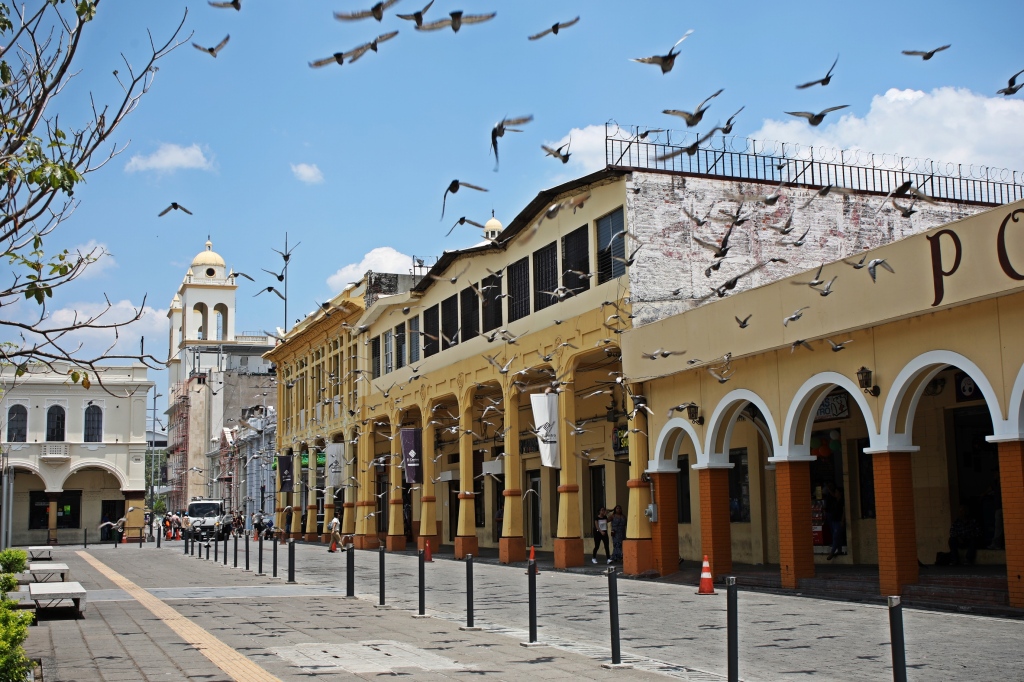
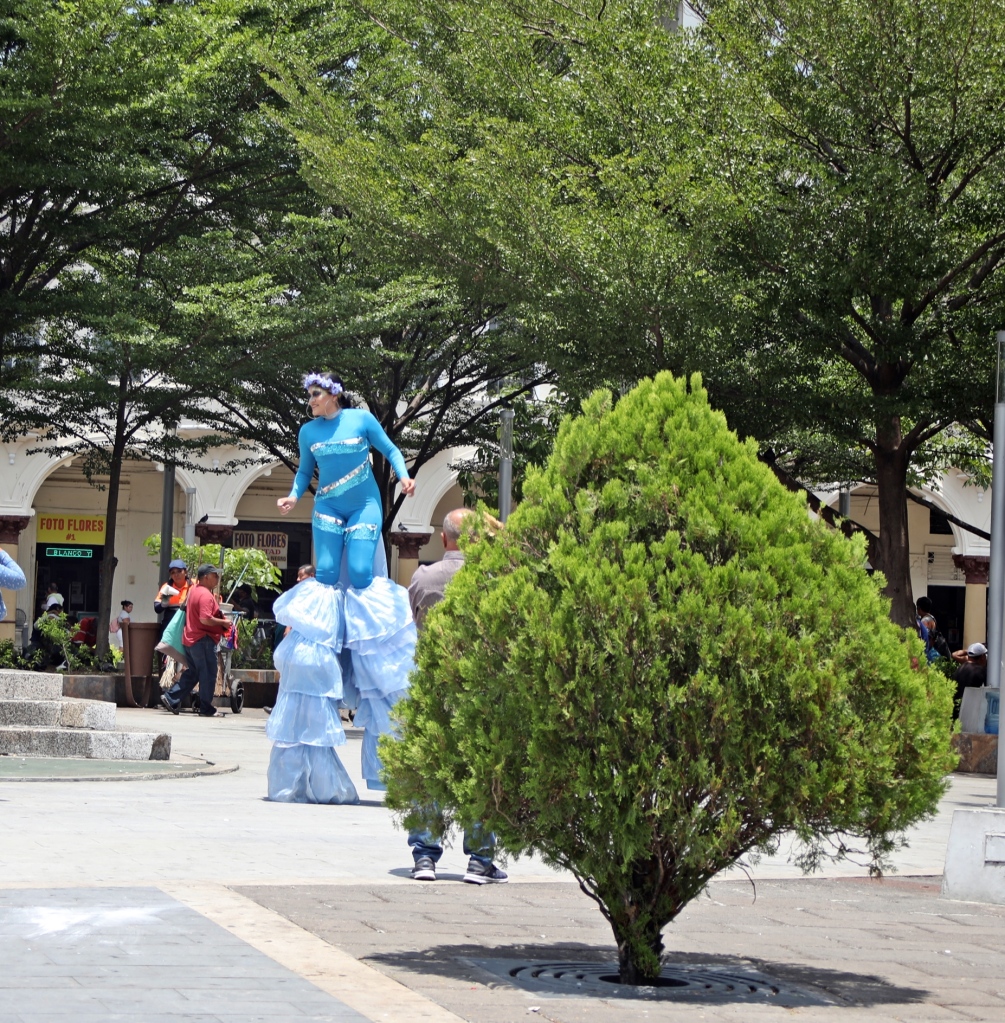
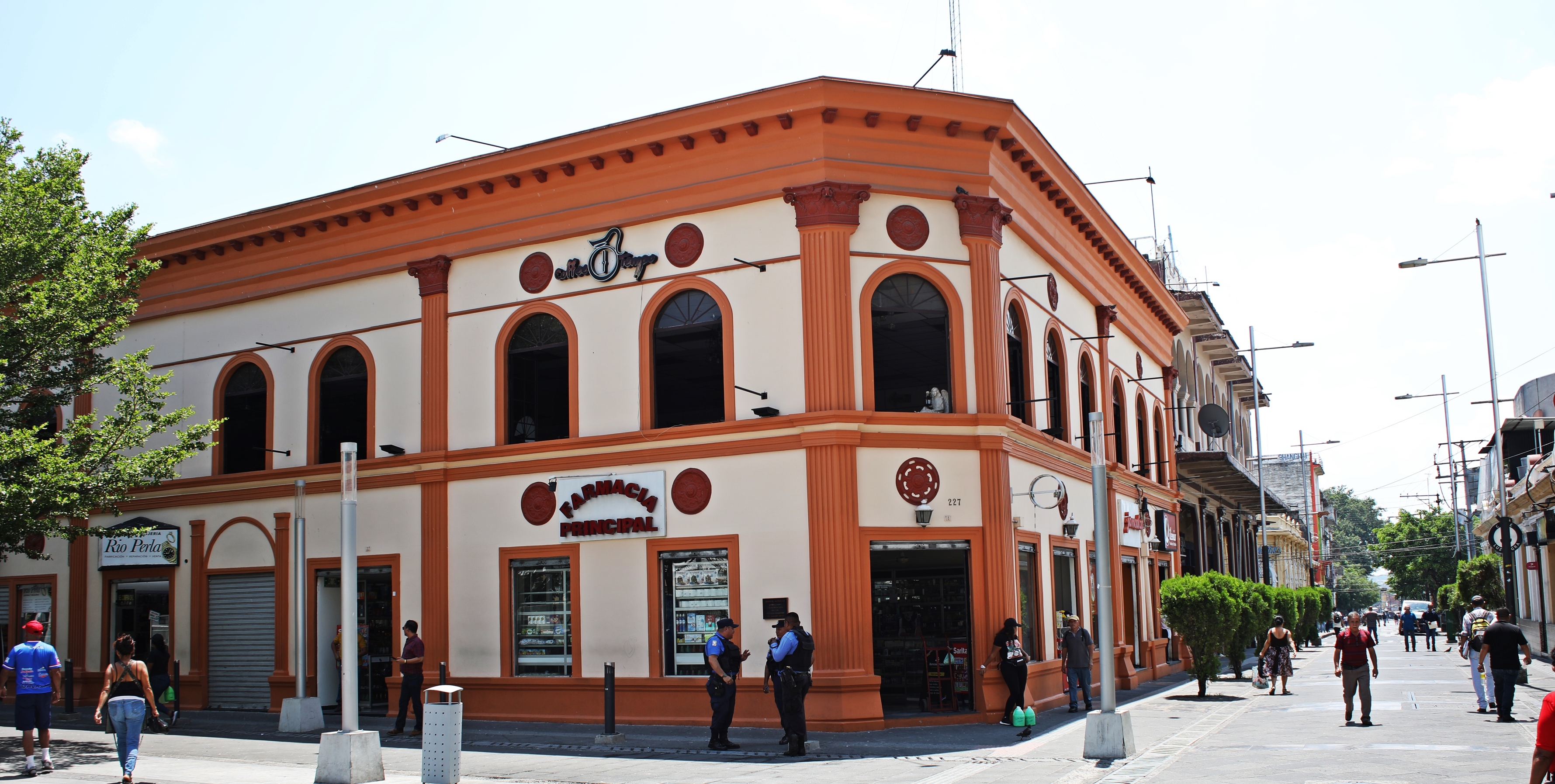
Walking in this area in the middle of the day felt very safe, but it is advised to avoid the area at night. As well, further away from these three plazas, the streets become rougher and don’t have much to offer visitors at the present time.
After spending the morning in the city’s downtown, you can spend your afternoon exploring Mayan history.
Joya De Cerén
While many parts of El Salvador were inhabited by the indigenous Pipils, the northwestern part of the country was settled by the Mayas. In the late 6th century, a Maya farming community was established in the fertile lands around Joya De Cerén. A previous volcanic eruption made the soil in this region very rich for farming, but probably should have been a warning sign.
The map below shows the historical distributions of pre-Hispanic civilizations across Mesoamerica. Joya De Cerén is in the red region (El Salvador).
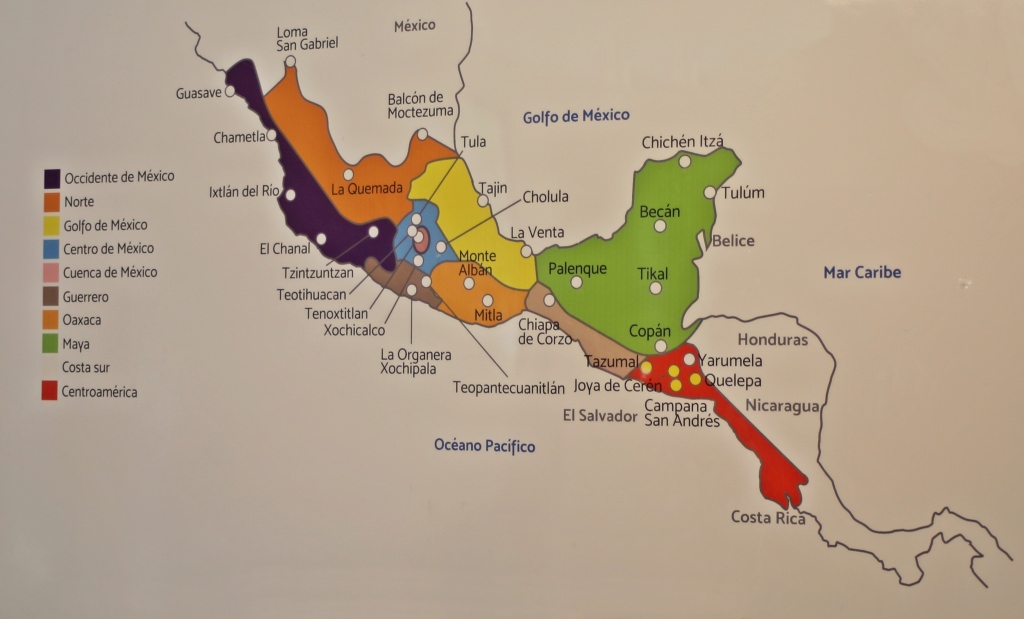
In 650 AD Loma Caldera erupted, covering this farming village in 4 – 8 metres (13-26 feet) of ash. For this reason, it is also called the Pompeii of El Salvador. The volcanic ash did a great job preserving the buildings of this community. While there are many stone Mayan temples and palaces that can be visited, everyday buildings were made of wood and clay so none survived. That is none, except for those in Joya De Cerén. It is one of the only Mayan sites that allows you to see how the common people lived.
The excavated buildings in Joya de Cerén archeological site are seen from viewing decks above three separate pits. Around the edges of the sites you can see the 14 layers of ash that covered the town for more than 1,000 years. The layers are not only from the original volcanic eruption, but also from subsequent eruptions, floods and earthquakes. In the middle of these pits are some of the well preserved buildings of this farming community. To put the pictures into perspective, remember that the ash wall that surrounds them is up to 8 metres (26 feet) deep.
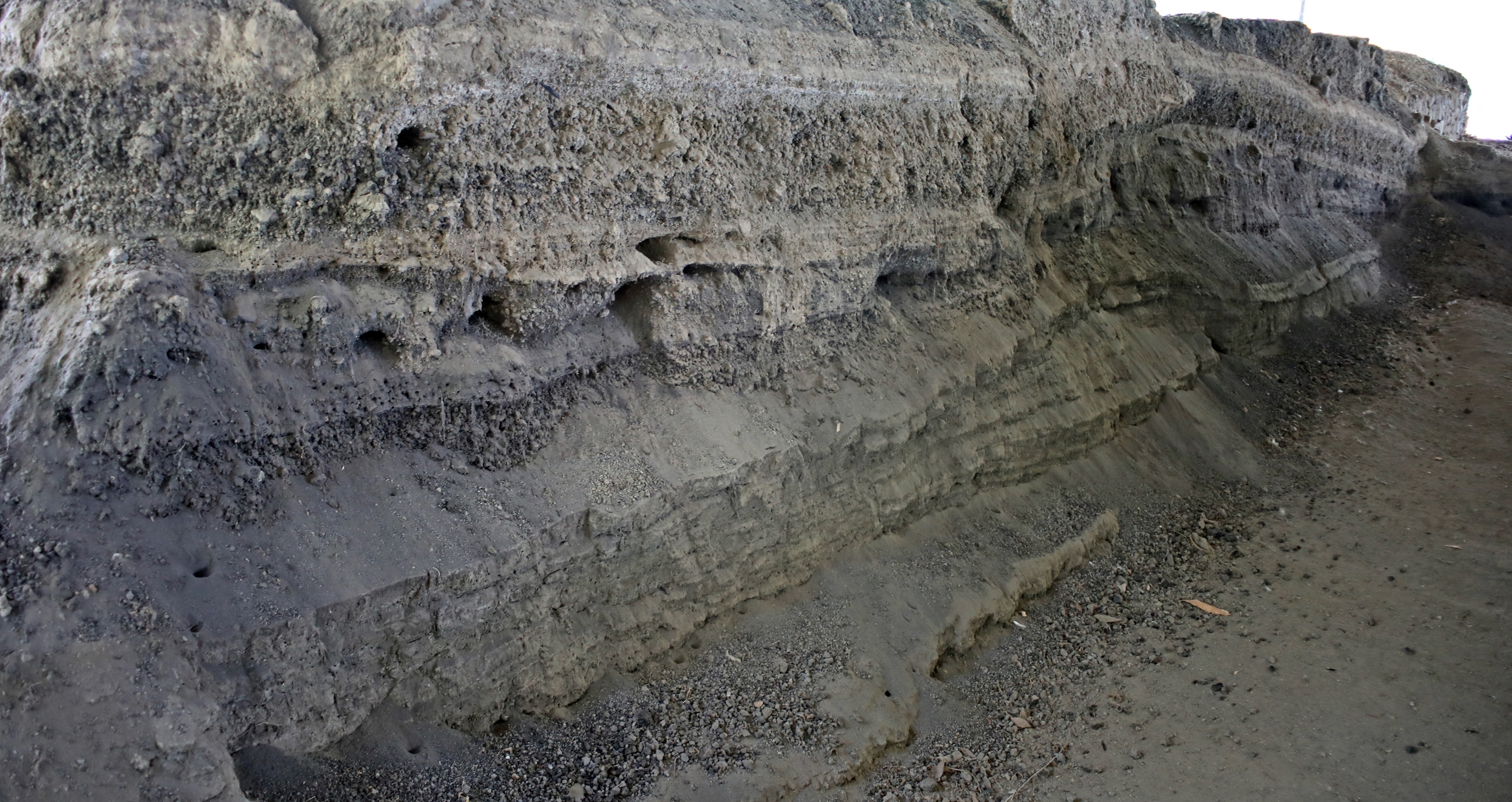
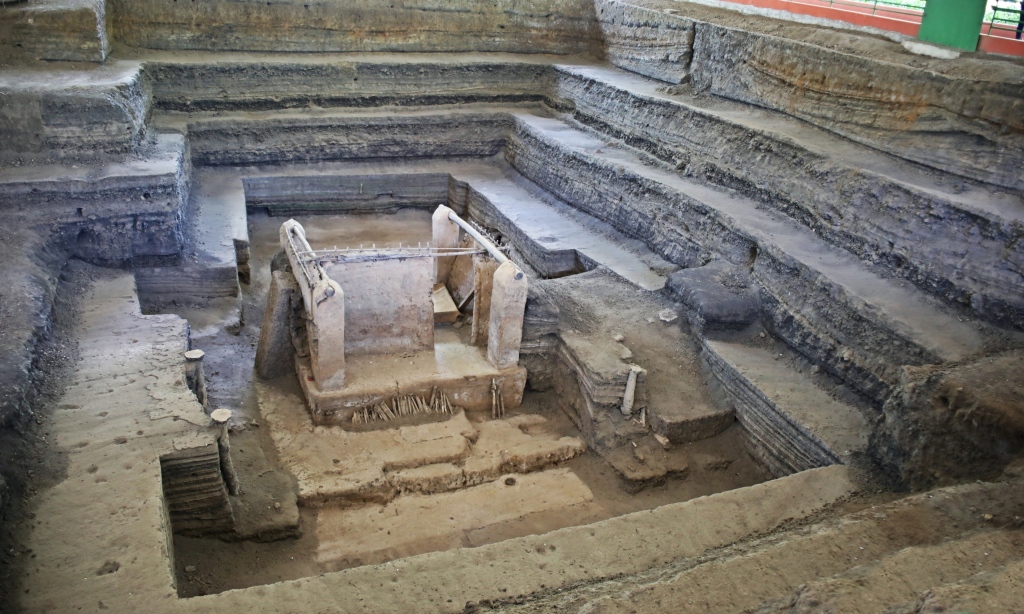
As we explored the site we saw a community building that was likely used for town meetings with seats at the front for authority figures. Other buildings were farm houses with separate storage rooms and crop fields.
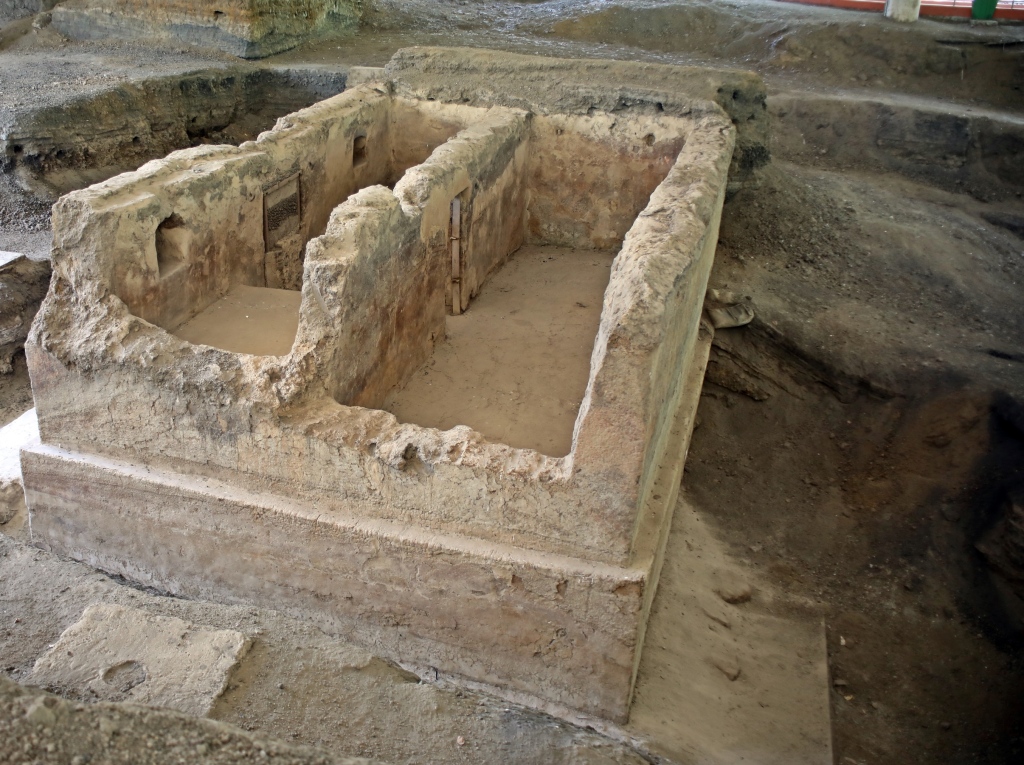
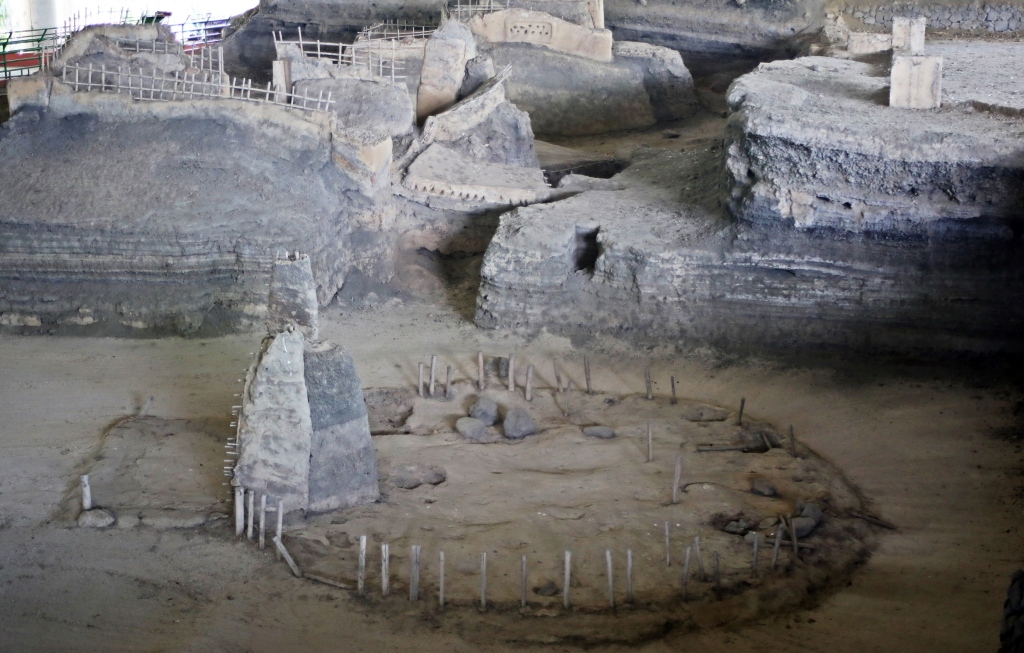
Further on is a female shaman’s house with lattice designs that reminded us of Pre-Incan sites in Trujillo, Peru. Beside it is the ceremonial centre where rituals related to corn harvest and fertility would have been performed.
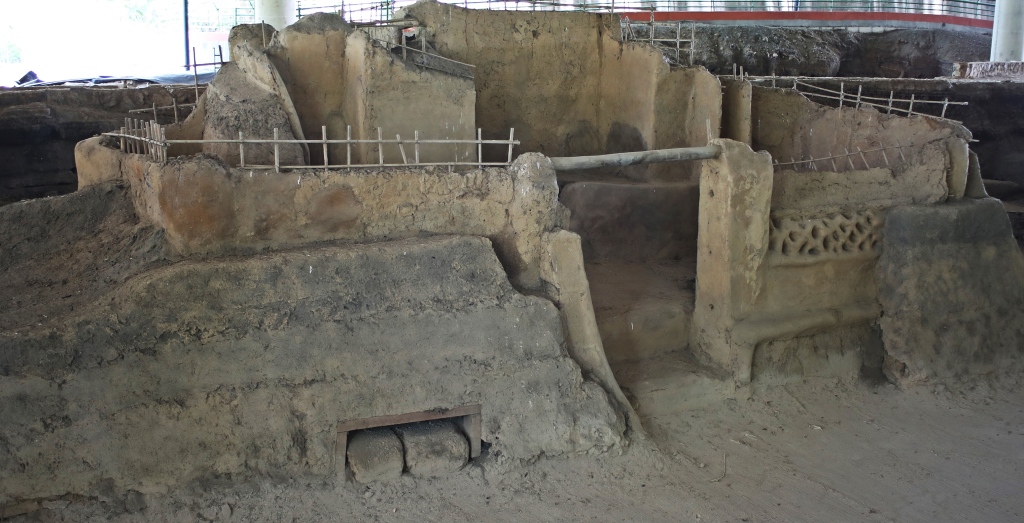
The condition of the buildings allowed researchers to better understand how Mayans built their homes in the 7th century. Most of the buildings were made of wattle and daub construction. In this technique wet clay, soil and gravel are compressed and applied to a wooden frame. It is known to be an earthquake resistant technique.
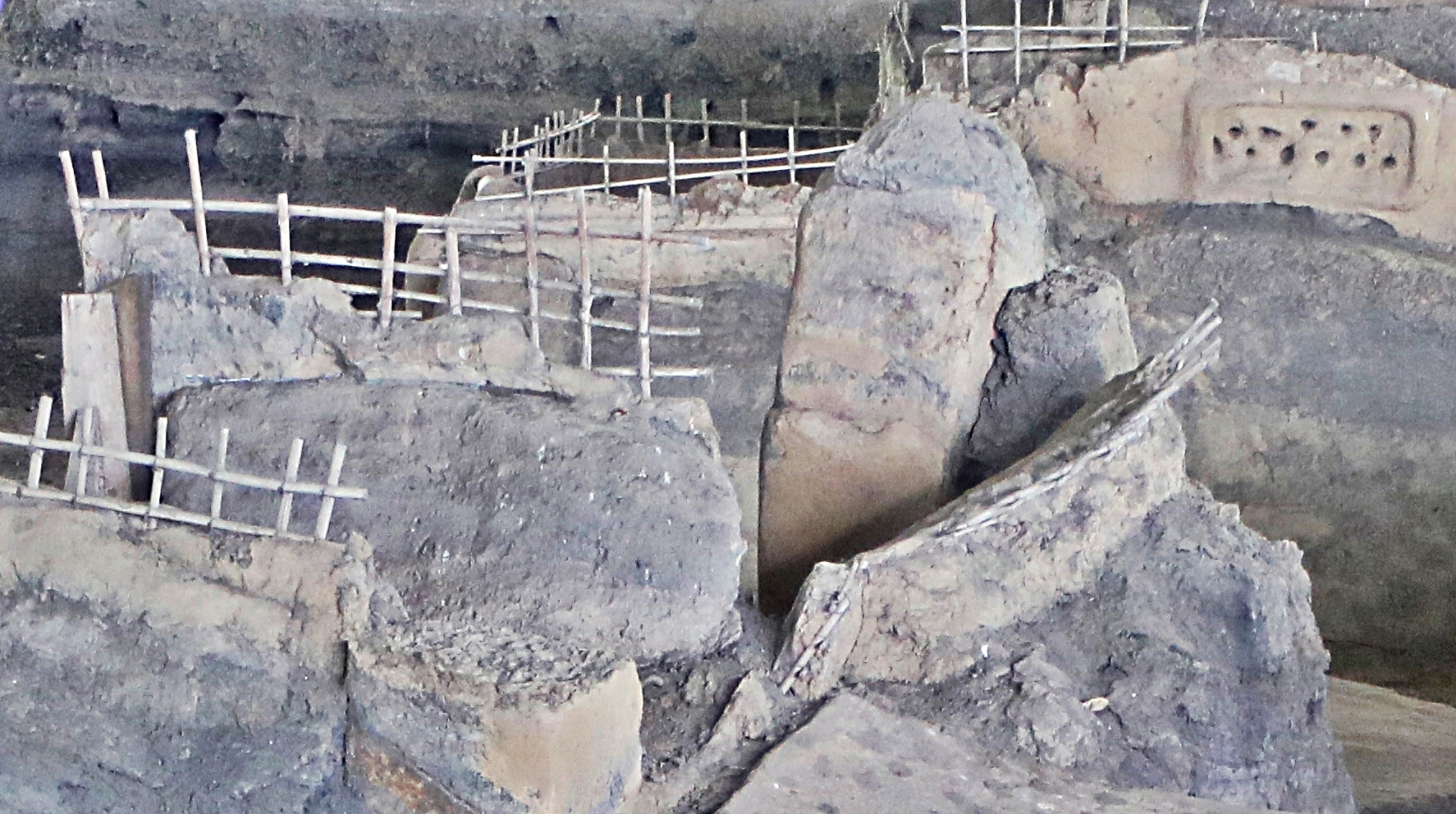
Loma Caldera was less than a kilometer away from the village. No bodies were found leading researchers to believe that the community was able to escape without losing any lives. Most of their belongings were left behind as if they left in a hurry indicating that the eruption was sudden, catching the community by surprise. Some of the dishes still had residue of the last meal and a ceramic vessel was found that still contained hundreds of pumpkin seeds.
The well preserved condition of the buildings and pottery resulted in other fascinating discoveries. Researchers found fingerprints on a piece of pottery and remarkably, human footprints in the ground. There were also indications that they raised animals. One example was the duck skeleton that was found still tied to a wooden rod.
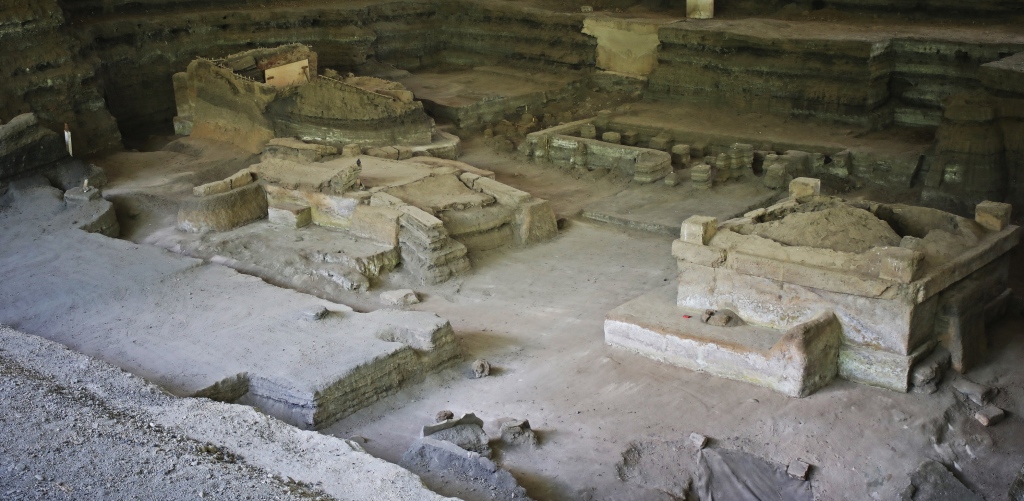
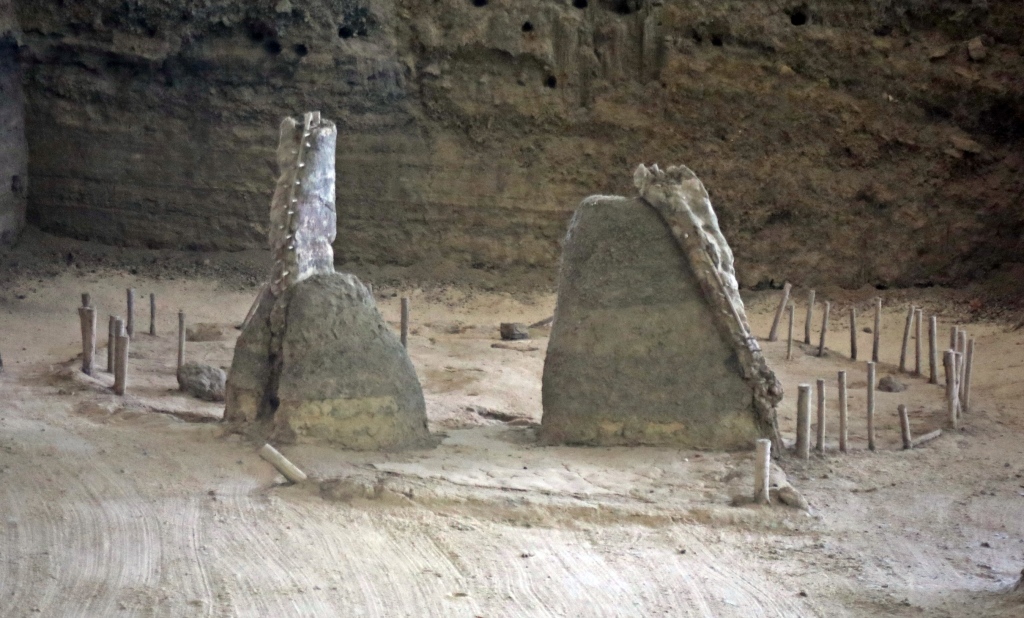
Not far from a group of houses is a sauna, called temazcal (also spelled temascal or temazcalli). This is one of the only Mayan saunas found that still has part of a domed roof. This finding allowed researchers to further understand the construction techniques used. They built the roof with sticks that were woven together and then covered in mud.
Inside the sauna is a flagstone floor and a stone box which would hold heated rocks. Water infused with herbs was then poured on top to generate steam. Saunas were used to purify the body after childbirth or when fighting an illness.
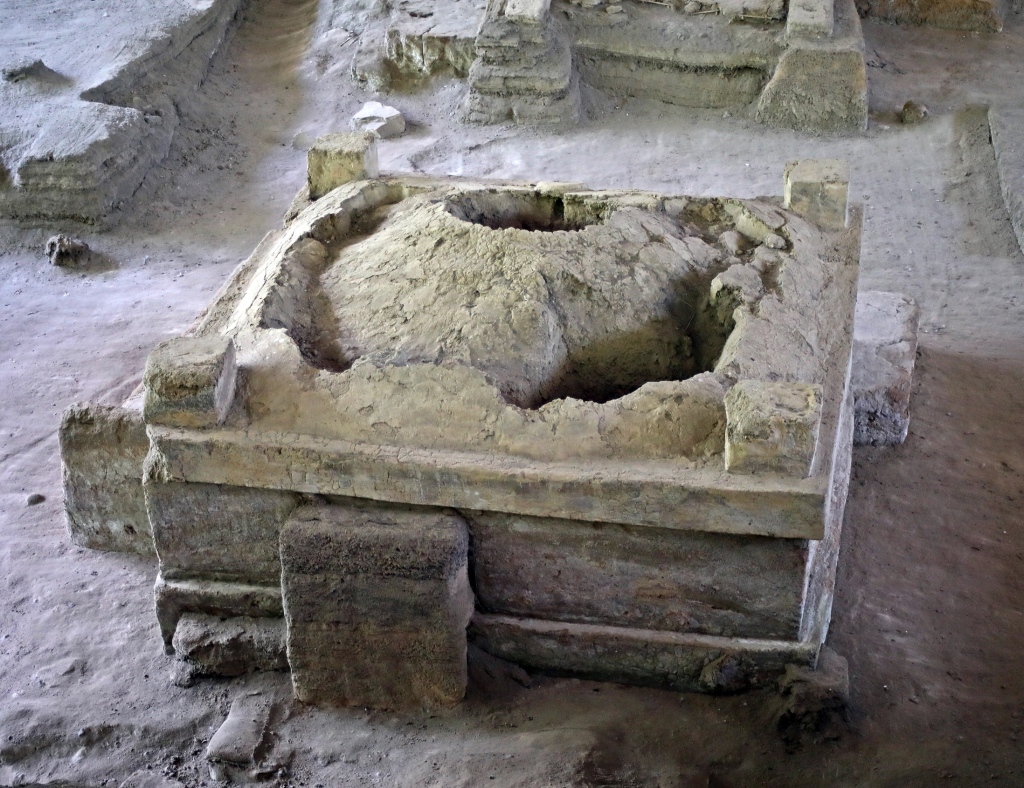
Archeologists found vessels, tools, funerary offerings, agave fibre ropes, jewelry and obsidian knives. Many are on display in the site’s small museum.
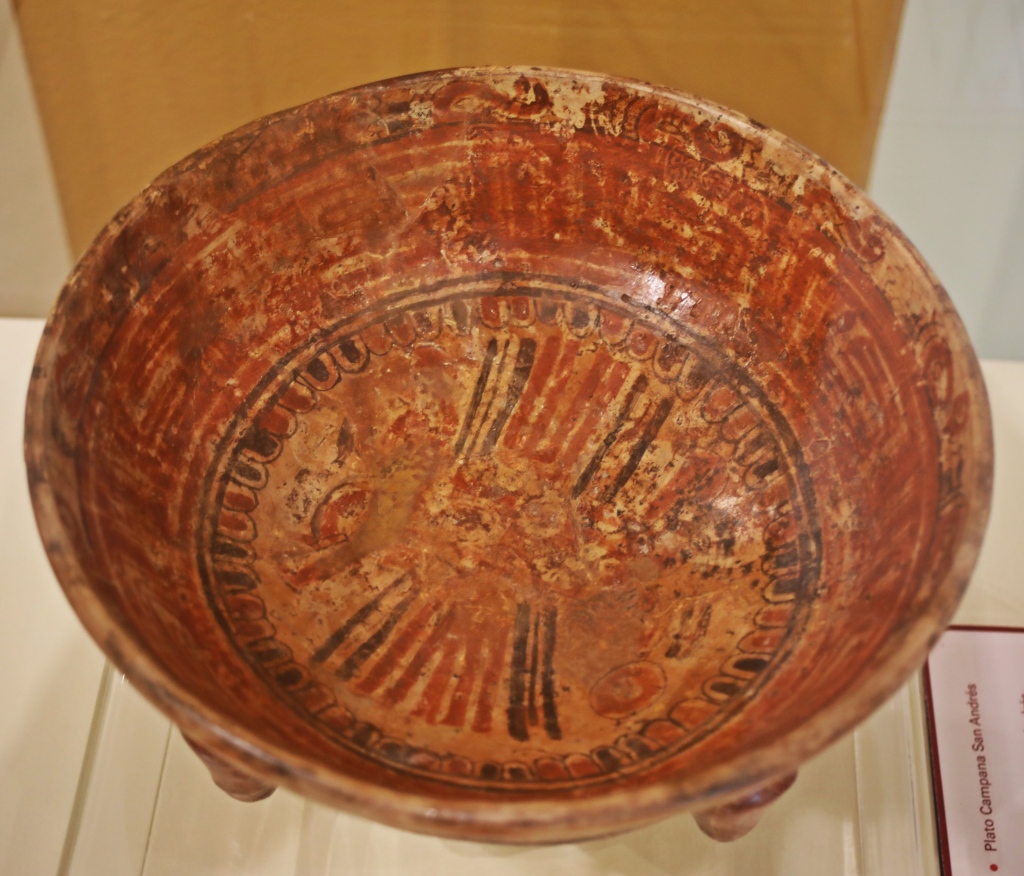

Entrance – $7 USD and includes an English speaking guide. Opening Hours – Tuesday to Sunday 9am-4pm.
How to get to Joya De Cerén
The archeological site is 34 km from San Salvador. If you don’t have a car, go to Terminal Occidente in San Salvador and take bus 108 destined for Opico. Tell the driver you’re going to Joya de Cerén and he will tell you when to get off.
You can also reach Joya De Cerén from Santa Ana as it is 41 km away. Take bus 201 or 202 for the 1 hour drive.
Where to stay in San Salvador
We stayed in San Benito neighbourhood and found its tree lined streets to be safe and filled with good restaurants and nice hotels. It is considered one of the safest neighbourhoods in the city. Its location makes it easy to reach downtown by Uber or taxi.
Getting to San Salvador
As the capital of the country, San Salvador has a large International Airport, but it is located 32 km from the city’s downtown. It is actually mid way between San Salvador and La Libertad.
If you’re already in the country, it is easy to reach San Salvador by chicken bus. There are at least three bus stations though, so make sure you know which one your bus uses, especially if you are transferring to another bus.
Note the term ‘direct’ for a chicken bus does not mean it doesn’t make stops. There will be countless stops along the way even when you think there can’t be room for any more people, it will stop to let more on. Direct means that you won’t have to change buses.
Getting around San Salvador
Chicken buses and micro-buses connect all parts of the city , but Uber is also a convenient and inexpensive option. Most of our Uber rides from San Bento to the downtown were between $3-5 USD.
Travel Tips For El Salvador
• Safety in El Salvador – Not that long ago El Salvador was considered one of the most dangerous countries in the world. Gang violence was rampant with frequent murders, kidnappings and extortions. Recent government crackdowns resulted in the arrest of at least 80,000 gang members. This seems to have ceased or at least greatly diminished the violence. It is Central America though, so you have to take everything with a grain of salt. Recently it was in the news item that a Salvadoran football (soccer) star asked the president to release his gangster father from prison and the president obliged. Hopefully that is not a common scenario.
According to United Nations, murder rates per 100,000 people in El Salvador in 2018 was 52.02. By 2022 it had decreased to 7.74 and has gone down even more since. Estimates are that El Salvador’s murder rate for 2023 will be around 2.4/100,000. For comparison, Mexico’s murder rate only improved from 29.58 in 2018 to 26.11 in 2022.
What all of this means for tourists is that the country is much safer for foreigners to travel. During the day tourist sites are safe and usually patrolled by heavily armed police or soldiers. You do still need be vigilant using safe practices such as: taking care when walking at night, not carrying a lot of cash or wearing flashy jewelry and taking extra precautions when outside of the tourist sites.
• SIM Cards – We purchased a SIM card from Claro for $7 USD. It gave us 26 days with 5 GBs data plus, 2 GBs for FB, IG, TikTok. We met another traveller who had an e-sim specifically for Guatemala and El Salvador. He said it worked well in Guatemala, but it didn’t work at all in El Salvador.
• ATM – Not all ATMs accept international bank cards and not all are always stocked with money. We found the banks with best rate and consistently had money were BAC Credomatic or Banco Atlántida. The country’s currency is the US dollar. They claim to also use bitcoin but we only saw one store that was accepting it.
• Transportation – Unless you rent a car or hire a private driver the most common way to reach the cities in El Salvador is by chicken bus. Don’t worry, even though at first glance they may look awful, they are a fun way to travel and immerse yourself in the culture. Vendors get on and off the bus throughout the trip selling water, juice, chips, fruit or even electronics and snake-oil medications.
If travelling with luggage, you will bring it inside the chicken bus. Sometimes you will be charged for an extra seat for the bag. It’s not pleasant to haul it onto the bus but it is also safer. We took a regular bus from Sonsonate to San Salvador where the luggage goes below the bus. Someone opened up the sleeping bag compartment of one of our backpacks. If you take a regular bus, watch your luggage and keep an eye on the luggage compartment at every stop.

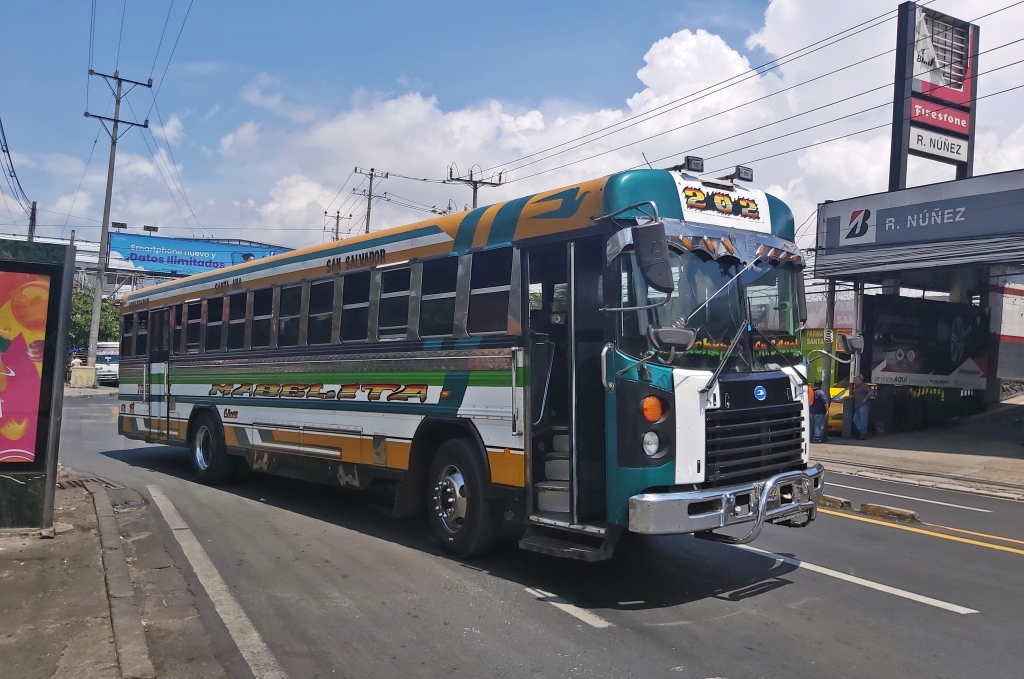
• Ride Share – Uber operates in San Salvador and El Tunco. Otherwise, taxis are available everywhere.
• Food – Pupusas are the most authentic and widely eaten Salvadoran food. Somewhat like flattened empanadas, pupasas are corn tortillas stuffed with either mushrooms, cheese, beans and sometimes chicken or pork. Other than pupasas, most food is similar to what we think of as Mexican food. Breakfast was similar to that found in other Central American countries with eggs, beans, fried plantains and buns.
• When to travel – The most popular time to visit is during dry season that runs between November and March. The hottest months are March and April. Rainy season is between May and October and would not be a good time to visit.

To read more of our adventures in El Salvador, click here.
Coming Next – Day Trips From Santa Ana El Salvador
For pictures from other blogs go to Gallery at monkeystale.ca
To read about more of our adventures go to Destinations.
If you like what you read, please comment or share (with credit) using the links below.
Looks like there are lots to see and do in a city that’s filled with culture, history, and food. What caught my eye right away was the mighty El Rosario Church and how the grey exterior is lacklustre compared to the interior, making it easy to overlook from the street. I love those stained-glass elements which lend the interior a vibrancy of dancing colours at all times of the day. I bet the church is particularly atmospheric during early morning and late in the day. Thanks for sharing by, and have a good day 🙂 Aiva xx
LikeLike
Wow! Joya De Cerén certainly caught my attention. The diggings and artifacts are totally captivating. This area alone would be worth the effort to see.
LikeLiked by 1 person
It really was worth it. Amazing what a good preservative volcanic ash is!!
LikeLiked by 1 person
What an interesting church. The style does not look pretty on the outside, but so worth it for the interior. What are the vendors selling on the chicken bus? Have a great Tuesday Maggie. Allan
LikeLiked by 1 person
The vendors will sell just about anything, but mostly food. The lady in the picture is selling drinks- juice, pop, and a lot that we didn’t know 😊
LikeLike
Amazing to think of that much ash, and having to escape it by pushing away from the dinner table and running for your life. Yikes.
Must be nice to have the president do your will. Also yikes.
Great tips at the end, too.
LikeLiked by 1 person
I know, the dishes with food in it really hit home. They really were running for their lives. The soccer star story was a good reminder that we’re still in Central America where it’s who you are and who you can bribe. But we did feel safer than parts of Mexico. Are you in Oz?
LikeLiked by 1 person
Not in Oz yet. Just finishing up my post about packing for Oz (sounds riveting, huh? 😂). Oh dear, we just booked our next spring break in Mexico – Playacar. Hope it’s safe!!
LikeLiked by 1 person
Oh ya, Playa is safe. In fact Yucatan is the safest part of the country. You need to learn to dive though. Cozumel diving is some of the best we’ve ever done!
LikeLiked by 1 person
The husband has multiple diving certifications and will probably do it several times. I did it once. That was enough for me. 🤿
LikeLiked by 1 person
If he does go tell him Maple Leaf Scuba is excellent, and not just because the owner is Canadian 😊
LikeLiked by 1 person
Such an interesting place. It is always nice to hear about an area that is beginning to stabilize after much violence.
LikeLiked by 1 person
Yes, after only hearing terrifying stories of El Salvador, it was nice to find the streets quite safe and the people friendly. It’s not over yet but I think they’re on their way.
LikeLiked by 1 person
That is a considerable decrease in the death rate thankfully! Joya De Cerén looks like a really cool place to visit, makes me very happy for the modern conveniences we have haha. I also love El Rosario Church, I’ve never seen anything like it.
LikeLiked by 1 person
The murder rates were shocking, but what an improvement. El Rosario is a unique building. It’s not my favourite style, but it was interesting to see. Thanks Lyssy! Maggie
LikeLike
Wow, that ceiling of the cathedral is something else (it makes my head spin)! There are quite a few interesting buildings here – yes, the The Rosary Church’s windows/linear breaks are certainly unique. Wow, a city that was covered under ashes for 1,000 years (and pumpkin seeds that have still been preserved after all these centuries) – that’s astonishing.
LikeLiked by 1 person
The amount of preserved food, buildings and pottery was staggering. It was almost like walking above a re-created village rather than one dug out of the ash. I love the cathedral ceiling too. It certainly received most of my attention 😊 Maggie
LikeLiked by 1 person
I do like the look of the Iglesia El Rosario and yes, I can see the resemblance to the cathedral in Rio. And Joya De Cerén would be fascinating to visit, with so many relics of the lives of ordinary Mayans.
LikeLiked by 1 person
As you know, visiting the pyramids you often learn that the hillside below would have been where the villagers live. Well finally, we got to see examples from those villages. Quite fascinating. Thanks Sarah.
LikeLiked by 1 person
What a great virtual tour, dear Maggie! I found the Rosary Church amazing
Great sharing as always! Thank you!
LikeLiked by 1 person
Thanks Luisa, the Rosary Church was filled with so many colours which was unexpected when we saw it from the outside.
LikeLiked by 1 person
Really amazing!!!!
LikeLiked by 2 people
The 14 Stations of the Cross was a masterful use of leftover construction materials from building the Rosary Church. The large modern buildings in San Salvador surprised me-although one wonders why China would help finance any of them. The ruins in Joya De Cerén were intriguing, especially the sauna. Thank you for the wonderfully educational tour! 🙂
LikeLiked by 2 people
China seems to like to have its hooks in many of these undeveloped countries. Being so far away though, made El Slavador a bit of a surprise.
Joya de Cerén is a fascinating site. To see farms and homes from 600AD, quite amazing.
The stations of the cross was a little odd for me, but you’re right a great use of left over construction materials.
Thanks Linda! Maggie
LikeLiked by 1 person
The Iglesia Rosario looks like a bridge from the outside! I’ve certainly never seen a church (or any building, actually) in that shape. Very unique! I’m also shocked by the amount of ash covering those ruins. My goodness. Humans are no match for a volcano. Lastly, I’m also very confused by the statues, not only because of who sent them, but also the timing. 432nd anniversary? What a random way to “celebrate.”
LikeLiked by 1 person
The randomness of the date, the fact that it would be celebrated post-colonialism, so many weird details to those statues. The inside of the church is so colourful compared to the bland concrete design. An odd assortment of things to see in San Salvador 😊
LikeLiked by 1 person
The Joya de Cerén archeological site is fascinating. I didn’t know that there was another site as similarly well preserved as Pompeii. Thanks for the interesting information about El Salvador. You might be interested in this Wikipedia entry about the global peace index which includes crime rates and 23 other safety parameters for the world’s countries. https://en.wikipedia.org/wiki/Global_Peace_Index.
LikeLiked by 1 person
Interesting list Lynette, El Salvador is in the middle so better for the people. Joya de Cerén is fascinating. We didn’t know anything about it either before visiting. Amazing the things they were able to find under the layers of volcanic ash. Maggie
LikeLiked by 1 person
Glad to hear that El Salvador became a safer place to visit!
Quite few interesting buildings in San Salvador, they had quite filled your day🙂
LikeLiked by 1 person
It is so great for the people that they can now live life in peace. I hope these changes are permanent. Thanks again 😊 Maggie
LikeLiked by 2 people
I think I could spend a whole day at the Mayan excavation site—fascinating!
LikeLiked by 1 person
It is really incredible! Fingerprints, footsteps, pumpkin seeds! What they found and in such good condition is remarkable. Thanks Mallee
LikeLiked by 1 person
Quite a tour, Maggie, from the modern to the ancient sites! Your travel tips are invaluable for others thinking of making this visit.
LikeLiked by 1 person
Thanks Rosaliene, it may not be on the top of everyone’s list, but El Salvador has a few gems worth seeing. 😊
LikeLiked by 1 person
Maggie, your posts are filled with historical and current information along with so many descriptive photos. You must have an in-depth understanding of humanity from all of your travels. Thank you for sharing what you’ve learned with your readers. I enjoy your travels very much.
LikeLiked by 2 people
Thank you so much Mary, I’m not sure I have an in-depth understanding, but we do have a deep desire to learn. Travel is a great way to try to understand people from every walk of life. Maggie
LikeLiked by 2 people
That is one massive library. Interesting to hear that it was built with financial help from the Chinese government. Iglesia El Rosario looks beautiful with all the stained glass windows. It also kinda looks like a bridge from the outside.
LikeLiked by 1 person
It does look like a bridge. We almost didn’t go in because it looks quite unwelcoming, but glad we did. Thanks Linda! Maggie
LikeLiked by 1 person
Thank you for the tour of San Salvador and of the Mayan community. It’s fascinating to see all the excavations. The volcanic eruption there reminded me of Florissant, and of how volcanic ash in both places entombed and protected structures that we can still examine today. Fascinating!
LikeLiked by 1 person
It’s remarkable what can be preserved by volcanic ash isn’t it?!
LikeLiked by 1 person
Indeed!
LikeLike
I grew up with a lot of El Salvadorians who migrated to Australia to eacape the trouble there, its nice to know it has become safer and they can now go back to visit their country.
LikeLiked by 1 person
That’s interesting that so many went to El Salvador. KZMB from Underdown remembered teaching a lot of Salvadorans in Australia too. I hope the country is able to maintain this peace for the sake of those people. Thanks Ana. Maggie i
LikeLiked by 1 person
It was interesting to see the brutalist church, not as spectacular as the Rio one and certainly not as elegant as the Niemeyer’s in Brasilia. But still impresive. Unfortunately, this type of architecture does not age very well. Also, the archaeological site seems to be very spectacular. You had a great tour in Salvador!
LikeLiked by 1 person
It’s much smaller than those churches, but you can see the resemblance. Joya de Cerén was fascinating. What they found under the ash is amazing. We found a few great spots in El Salvador! 😊
LikeLiked by 1 person
What amazing discoveries lay beneath the ash layers, how absolutely fascinating to read what items and remnants had been so well preserved. Funnily we recently ate our first ever pupusas, in an El Savador family restaurant in the suburbs of LA. They were good!
LikeLiked by 1 person
Like many dishes, pupusas need a good cook. We had some really good ones and some with absolutely no flavour but all were cheap and filling.
Finding pumpkin seeds and dirty dishes at an archeological site must have been so exciting! After seeing so many Mayan pyramids over the years it was great to see a village and farms. I read one report that said the buildings are already starting to deteriorate from being exposed to weather so they may not excavate anymore. Who knew ash was so good?!
LikeLiked by 1 person
I love that mix of old world and new age everywhere from the archeology site to those fantastic windows in the Iglasia Rosario. I love that for a country I’ve never really given much thought to before, now I am very interested in visiting there 🙂
LikeLiked by 1 person
El Salvador does have quite the mix of ancient, colonial and modern. I think in a few years, as they’ve had more time to rebuild, there will be a lot more tourist sites in the country. Thanks Meg!! Maggie
LikeLiked by 1 person
A great review of how to spend a day in San Salvador, another city I knew nothing about!
LikeLiked by 1 person
Thank you, not many people know much about it, but maybe one day it will be a bigger draw for travellers 🙂 Maggie
LikeLiked by 1 person
The cathedral in San Salvador is stunningly magnificent. It’s good to know that the country is much safer now; that benefits everyone. I thought we had a lot of ash in eastern Washington when Saint Helens blew, but that seems pretty insignificant compared to what those running for their lives from the dinner table dealt with; scary! I think I asked this already, but are you in Mexico now?
LikeLiked by 1 person
We’re home now, likely will be for the summer for a change. We just arrived this week. The dinner plates with food and 1000 year old pumpkin seeds are quite an amazing find aren’t they? Thankfully St Helen’s was not nearly as bad as this one, but it would have been scary to live so close to it. I really hope the safe conditions continue for the country, it now makes Guatemala look quite bad although it felt safe when we were there.
LikeLiked by 1 person
This sounded like a fabulous adventure with lots to do! I love the photo of the birds in flight over the street. Fantastic capture.
Thank you for the great information on the buildings in San Salvador. The impressive National Theatre building looks very French styled as you mentioned. With all the financial challenges of the place I wonder how they funded the construction of these buildings?
The Iglesia Rosario is amazing! I have never seen a church like that before. Totally different architectural style and more “modern” than other buildings in the city. I did not see any columns in the photos of the Iglesia. How are those huge concrete and black metal walls supported, I wonder?
The great discovery at Joya de Cerén Mayan speaks volumes to the people who lived in those times. I was fascinated by all the clearly distinct structures and the clarity of what they were used for still visible after so many centuries. They must have been great builders and planners. Glad to hear that many survived the perils of those times.
As always thank you for being candid about the levels of safety on your travels. I am glad to hear that things are advancing where the visitor feels safe in San Salvador and El Savador in general. That is good news!!.
Thank you Maggie for this bespoke presentation of the many many great places you visit. And safe travels!
LikeLiked by 1 person
Thanks so much Suzette! When they achieved independence El Slavador had good revenue from coffee and other agriculture, that was the reason for so many theaters etc. I talk about this in the next post 😊
Iglesia Rosairo is quite amazing isn’t it? I’m no building expert but as I understand it there is a lot of rebar in the concrete ceiling.
Joya de Cerén is such a special place. The artefacts that archeologists were able to find and in such good condition is incredible. You’re right, they were phenomenal builders and if it weren’t for a volcanic eruption, we might never know!
We really hope that the new safety levels in the country continue, the people really deserve a safe place to live. Thanks for your detailed reading and curiosity 😊 Maggie
LikeLiked by 1 person
Ah yes, coffee, how could I forget their beautiful gift to the world. The revenue from coffee is an economical staple. Thanks Maggie, great point. Thanks for the great and detailed added information, Maggie, and for your patience with my curiosity! Blessings!
LikeLiked by 1 person
The archaeological sitesounds fascinating
LikeLiked by 1 person
It was really interesting. They learned so much for this site
LikeLike
San Salvador is quite an interesting mix of sights. The statutes of Columbus and Isabel la Catòlica are indeed surprising, mostly that they are still there. That archeological sight is every bit as fascinating as Pompey. Dirty plates and pumpkin seeds, it is such a fantastic document of life. Of people having to flee the impending doom. This was a very interesting read that afforded me insight into a city I am not familiar with.
LikeLiked by 1 person
I was very surprised to see the statues in front of the palace. And mostly because they hadn’t been torn down. It still seems rather odd.
It was fascinating to see what they found at Joya de Cerén. It’s like a sketch of everyday life down to small details. Glad you enjoyed it Leighton!! Maggie
LikeLiked by 1 person
It’s very refreshing to read your travel stories from El Salvador. And I certainly have never come across any other blog post on the capital San Salvador. When I saw your photos of Iglesia El Rosario, I immediately thought of the cathedral in Rio as well! How interesting that you also went to Joya De Cerén. The setting reminds me of what was once a village right on the slope of Mount Merapi in Java, Indonesia’s most active volcano.
LikeLiked by 1 person
Can you visit the village on Merapi? It would be interesting to see how well things were preserved there. Joya de Cerén was fascinating, mostly to find out what they learned and found. I’m not sure I’d put El Salvador high on people’s travel list yet, but it had more to see and was much safer than we thought.
LikeLiked by 1 person
Actually you can. It’s a popular site among tourists now, especially those who come from the southern slope of the volcano (usually on a day trip from Yogyakarta).
LikeLiked by 1 person
What a wonderful report of a city which has a notorious reputation. Like you I find the statue of Colombus and Isabel very odd and not with the times!! The archaeological site also looks a fascinating insight in to ancient civilisations – I wish I knew more about the Mayans, they were just so advanced.
LikeLiked by 1 person
We visited a lot of Mayan sites on this trip so I’ll slowly start releasing the details. It’s strange that the statues are still standing.
LikeLike
Those ruins look pretty fascinating. It’s not often that “daily life” is preserved like that.
My fave thing about San Salvador is Iglesia Rosario. What a fabulous building.
Alison
LikeLike
Iglesia Rosario…super cool! Did you wander on your own or have a guide?
LikeLiked by 1 person
We were on our own. Iglesia Rosario is a work of art. Thanks Beth
LikeLike